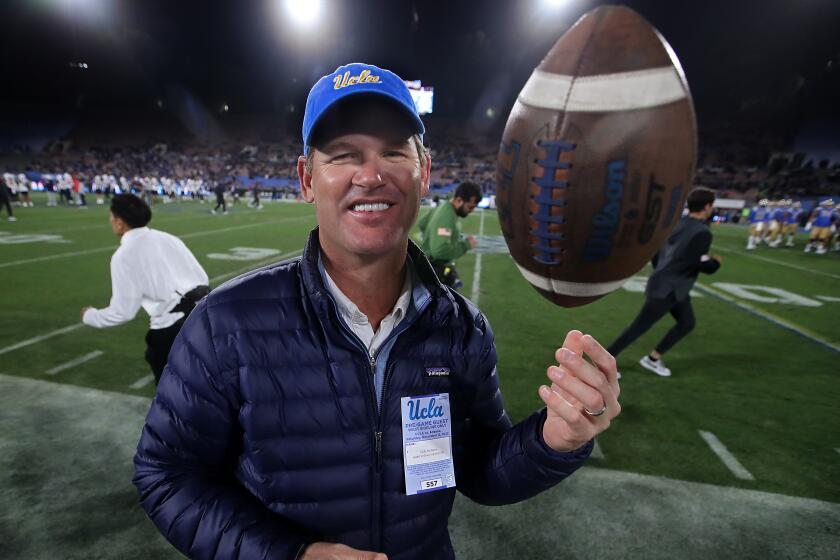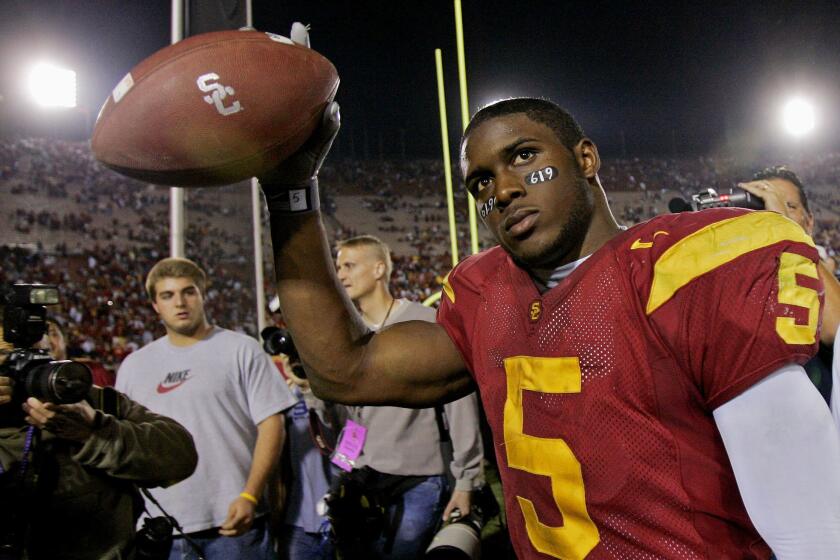Adjusting in a rush
The football season started with a bang for Chris Polk of Redlands East Valley. Well, actually, it was really more like a thud.
Starting at running back for the first time in his three-year varsity career, Polk took a handoff on the opening play from scrimmage and darted toward the line. A receiver by nature and running back out of necessity, the USC-bound senior was met head-on by a Riverside North defender, who planted him on his backside.
Quick physics lesson: Most successful running backs benefit from a low center of gravity.
Polk, at 6 feet 1, proved to be a quick study, scoring two second-quarter touchdowns that paved the way for a 21-20 upset of North. It was the first of three victories for Redlands East Valley over opponents ranked in The Times’ top 25, and Polk had his footprints on each of them.
“He’s an athlete,” said Colton defensive end Damien Holmes, a UCLA-bound senior who watched him rush for 195 yards in 22 carries and score the winning touchdown in the final minute of his team’s 19-15 loss to the Wildcats. “He’s a tough guy.”
A week later against visiting Compton Dominguez, which has a defense anchored by three players headed to Division I programs, Polk delivered his most impressive effort to date, rushing for 239 yards in 15 carries and scoring four touchdowns in a 44-14 victory. It was his first of four consecutive 200-yard rushing performances.
“He’s real good,” said Dominguez linebacker Maurice Simmons, who has committed to USC. “He knows how to read the holes real good. He knows how to read the cutbacks, everything.”
Polk piled up impressive statistics while playing receiver the last two years, catching 126 passes for 1,931 yards and 18 touchdowns. He also alternated at running back, rushing for a team-high 446 yards as a sophomore and a team-leading 11 touchdowns last season, mostly in short-yardage situations.
But sophomore quarterback Tyler Shreve replaced three-year starter Ronnie Fouch, who is now at Washington, and the Wildcats had another void to fill at running back, left by the graduation of Kevin Cantos, who rushed for 445 yards in 70 carries and scored four touchdowns, and Joshua Garcia, who had 413 yards in 70 carries and three touchdowns.
Coach Kurt Bruich decided to move Polk to the offensive backfield this season, where he hadn’t played full-time since his Pop Warner days.
“I’d be stupid not to give him the ball a lot,” Bruich explained.
Other coaches say they’ve contemplated similar moves.
Mike Sands of Lake Elsinore Temescal Canyon mulled a move of speedy quarterback Jonathan Warzeka to running back, but decided Warzeka was still the best candidate to run his option offense.
“The bottom line, are you doing it to make the team better?” Sands said. “I would hope that’s the reason.”
Polk says he understands the inherent risks of playing running back, but if the move makes his team better, he believes it’s worth the risk.
“I’ll do what I need to for the team to win,” he said.
And winning is what Redlands East Valley has done. The Wildcats will try to improve their 6-0 overall and 3-0 Citrus Belt League records when they travel to Rialto (1-5, 0-3) for a league game at 7 p.m. Friday.
As far as a running back’s challenges, they’re considerably different than those faced by a receiver.
“You have to take hits over the middle and they’ll try” to strip the ball, Polk said. “You have to cover it and just keep your feet moving.”
Ideally, a running back needs a lower center of gravity when running between the tackles because he’ll take a lot more hits from different angles. The more erect his posture, the more shots he’ll have to endure. Receivers typically operate in more open space and don’t have to avoid as many tacklers.
Trying to strip the ball from a receiver is a risk because if the attempt is unsuccessful, the receiver will probably break the tackle and keep running. There are more teammates near a running back, so defenders can take the chance of going for the strip knowing they have backup.
After watching tape of the Dominguez game, Bruich said he was amazed by Polk’s maturation in Redland East Valley’s one-back offense, which relies on zone blocking between the tackles, forcing the running back to find a hole in the blink of an eye.
“I’m impressed by how much more comfortable he’s getting,” Bruich said. “He has to find the crease and hit it, and he was able to find it every time.”
And when Polk was able to get through the first line of defense, he proved nearly uncatchable in the secondary, breaking off three long scoring runs against a defense thought to be among the fastest in the Southland.
Bruich, as well as opposing coaches, also say Polk is playing with more intensity this fall.
“We’ve kind of hurt him each year we’ve played him,” Colton Coach Harold Strauss said. “And even in our game he went out for a quarter, but he came back in the end. He showed a lot of heart to finish off that drive.”
Polk has 1,140 yards -- a 13-yard average -- and 14 touchdowns in 88 carries. He also has 11 receptions for 199 yards and four touchdowns.
Bruich expects Polk to revert to receiver at USC, since it was his pass-catching skills that caught the eye of the Trojans.
Bruich said USC coaches watched a highlight tape shortly after Polk’s junior season and promptly offered him a scholarship. Polk orally committed during halftime of a USC-California men’s basketball game last February.
“USC is very smart to get him early,” Bruich said. “They saw the tape and they went right after him.”
Making the Trojans one of the few teams to catch him this year.
Go beyond the scoreboard
Get the latest on L.A.'s teams in the daily Sports Report newsletter.
You may occasionally receive promotional content from the Los Angeles Times.



